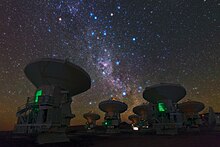
Back قياس تداخل مديد القاعدة Arabic Very Long Baseline Interferometry Catalan Very Long Baseline Interferometry German Interferometría de muy larga base Spanish تداخلسنجی خط پایه بسیار طولانی Persian Interférométrie à très longue base French Dugobazična interferometrija Croatian Very-long-baseline interferometry ID Interferometria a lunghissima base Italian 超長基線電波干渉法 Japanese



Very-long-baseline interferometry (VLBI) is a type of astronomical interferometry used in radio astronomy. In VLBI a signal from an astronomical radio source, such as a quasar, is collected at multiple radio telescopes on Earth or in space. The distance between the radio telescopes is then calculated using the time difference between the arrivals of the radio signal at different telescopes. This allows observations of an object that are made simultaneously by many radio telescopes to be combined, emulating a telescope with a size equal to the maximum separation between the telescopes.
Data received at each antenna in the array include arrival times from a local atomic clock, such as a hydrogen maser. At a later time, the data are correlated with data from other antennas that recorded the same radio signal, to produce the resulting image. The resolution achievable using interferometry is proportional to the observing frequency. The VLBI technique enables the distance between telescopes to be much greater than that possible with conventional interferometry, which requires antennas to be physically connected by coaxial cable, waveguide, optical fiber, or other type of transmission line. The greater telescope separations are possible in VLBI due to the development of the closure phase imaging technique by Roger Jennison in the 1950s, allowing VLBI to produce images with superior resolution.[2]
VLBI is best known for imaging distant cosmic radio sources, spacecraft tracking, and for applications in astrometry. However, since the VLBI technique measures the time differences between the arrival of radio waves at separate antennas, it can also be used "in reverse" to perform Earth rotation studies, map movements of tectonic plates very precisely (within millimetres), and perform other types of geodesy. Using VLBI in this manner requires large numbers of time difference measurements from distant sources (such as quasars) observed with a global network of antennas over a period of time.
- ^ Cite error: The named reference
APJL-20190410was invoked but never defined (see the help page). - ^ R. C. Jennison (1958). "A Phase Sensitive Interferometer Technique for the Measurement of the Fourier Transforms of Spatial Brightness Distributions of Small Angular Extent". Monthly Notices of the Royal Astronomical Society. 119 (3): 276–284. Bibcode:1958MNRAS.118..276J. doi:10.1093/mnras/118.3.276.